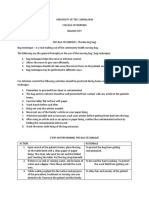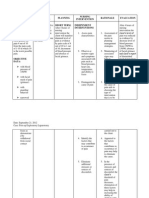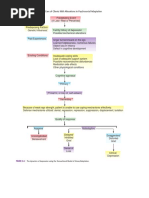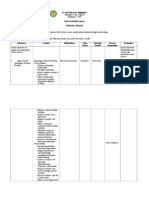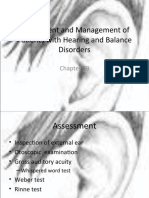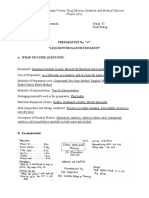0 ratings0% found this document useful (0 votes)
540 viewsChn-Herbal Medicine
Chn-Herbal Medicine
Uploaded by
BSN 1-N CASTRO, RicciCarl Linnaeus is famous for his work in taxonomy, the science of identifying and classifying organisms. The Traditional and Alternative Medicine Act of 1997 created the Philippine Institute of Traditional and Alternative Health Care to develop traditional herbal medicines in the Philippines. The document provides reminders on safely using herbal medicines and describes 10 herbal plants approved by the Department of Health, including their uses and methods of preparation.
Copyright:
© All Rights Reserved
Available Formats
Download as PDF, TXT or read online from Scribd
Chn-Herbal Medicine
Chn-Herbal Medicine
Uploaded by
BSN 1-N CASTRO, Ricci0 ratings0% found this document useful (0 votes)
540 views5 pagesCarl Linnaeus is famous for his work in taxonomy, the science of identifying and classifying organisms. The Traditional and Alternative Medicine Act of 1997 created the Philippine Institute of Traditional and Alternative Health Care to develop traditional herbal medicines in the Philippines. The document provides reminders on safely using herbal medicines and describes 10 herbal plants approved by the Department of Health, including their uses and methods of preparation.
Original Title
CHN-HERBAL MEDICINE
Copyright
© © All Rights Reserved
Available Formats
PDF, TXT or read online from Scribd
Share this document
Did you find this document useful?
Is this content inappropriate?
Carl Linnaeus is famous for his work in taxonomy, the science of identifying and classifying organisms. The Traditional and Alternative Medicine Act of 1997 created the Philippine Institute of Traditional and Alternative Health Care to develop traditional herbal medicines in the Philippines. The document provides reminders on safely using herbal medicines and describes 10 herbal plants approved by the Department of Health, including their uses and methods of preparation.
Copyright:
© All Rights Reserved
Available Formats
Download as PDF, TXT or read online from Scribd
Download as pdf or txt
0 ratings0% found this document useful (0 votes)
540 views5 pagesChn-Herbal Medicine
Chn-Herbal Medicine
Uploaded by
BSN 1-N CASTRO, RicciCarl Linnaeus is famous for his work in taxonomy, the science of identifying and classifying organisms. The Traditional and Alternative Medicine Act of 1997 created the Philippine Institute of Traditional and Alternative Health Care to develop traditional herbal medicines in the Philippines. The document provides reminders on safely using herbal medicines and describes 10 herbal plants approved by the Department of Health, including their uses and methods of preparation.
Copyright:
© All Rights Reserved
Available Formats
Download as PDF, TXT or read online from Scribd
Download as pdf or txt
You are on page 1of 5
HERBAL MEDICINES
CARL LINNAEUS • Stop giving the herbal medication in case
• Swedish botanist an untoward reaction such as an allergy
• is famous for his work in Taxonomy occurs.
TAXONOMY • If signs and symptoms are not relieved
• the science of identifying, naming, and after 2 or 3 doses of herbal medication,
classifying organisms (plants, animals, consult a doctor
bacteria, fungi & more)
10 HERBAL MEDICINES APPROVED
REPUBLIC ACT 8423
BY THE DOH
• otherwise known as TAMA
1. Sambong (Blumea balsamifera)
TRADITIONAL AND ALTERNATIVE MEDICINE
ACT OF 1997
• an act creating the Philippine Institute of
Traditional and Alternative Health Care
(PITAHC) to accelerate the development of
traditional and alternative health care in
the Philippines, providing for a traditional
and alternative health care development
fund and other purposes • Reaches 1 ½ to 3 meters in height with
REMINDERS ON THE USE OF HERBAL rough hairy leaves
MEDICINE • Young plants around the mother plant
• Avoid the use of insecticides as these may may be separated when they have 3 or
leave poison on plants. more leaves
• In the preparation of herbal medicine, use • Is not a medicine for kidney infection
a clay pot and remove the cover while USES
boiling at low heat. • Anti-edema
• Use only the part of the plant being • Diuretic
advocated. • Anti-urolithiasis
• Follow accurate dose of suggested PREPARATION
preparation. • Boil chopped leaves in water for 15
• Use only one kind of herbal plant for each mins until 1 glassful remains. Cool
type of symptom or sickness. and strain
• Use only half the dosage prescribed for • Divide into 3 parts. Drink 3x a day
fresh parts like leaves when using dried 2. Akapulko (Cassia alata).
parts. .
• Decoctions lose potency after some time.
Dispose of decoctions after one day.
• To keep fresh during the day, keep
lukewarm in a flask or thermos.
• Leaves, fruits, flowers, or nuts must be
mature before harvesting.
• Less medicinal substances are found on • Ringwormn Bush
young parts. • Bayas-bayasan and inser5t
• 1-2 meters tall
HERBAL MEDICINES
• Leaves are embraced with 8-20 4. Tsaang Gubat (Carmona retu)
elliptical-shaped leaves
• Has flowers with oblong sepal
USES
• Anti-fungal
o Tinea Flava
o Ringworm
o Athlete’s Foot
o Scabies
PREPARATION
• Forest Tea or Wild Tea
• Fresh, matured leaves are pounded • A shrub with small, shiny nice-
• Apply as soap to the affected part looking leaves that grows in wild
1-2x a day uncultivated areas and forests
3. Niyug-niyogan (Quisqualis indica L.) USES
• Diarrhea
• Stomach ache
PREPARATION
• Boil chopped leaves in 2 glasses of
water for 15 mins or until the water
goes down to 1 glass. Cool and
strain
• Chinese Honey Suckle • Wash leaves and chop.
• Vine which bears tiny fruits and • Boil chopped leaves in 1 glass of
grows wild in backyards water for 15 mins.
• Seeds must come from mature, • Cool and strain
dried but newly opened fruits 5. Ampalaya (Momordica charantia)
• Propagated through stem cutting
about 20cm in height
USES
• Ant-helminthic
PREPARATION
• Seeds are eaten raw 2 hours before
the pt’s last meal of the day
• Bitter gourd/ bitter melon
• Adults may take 10 seeds; children
• Tendrils grow up to 20 cm long
4-7 years may eat up to 4 seeds
• Heart-shaped leaves w/c are 5-10cm
only; ages 8-9 may take 6 seeds and
in diameter
7 seeds may be eaten by ages 10-12
• Fruits have a ribbed and wrinkled
years old
surface that is fleshy green with
pointed ends at length and have a
bitter taste.
USES
• Lowers blood sugar
HERBAL MEDICINES
• Diabetes Mellitus (mild non-insulin- water to produce a glass full of
dependent) decoction 3x a day
PREPARATION • For skin diseases (dermatitis,
• Gather and wash young leaves very scabies, ulcer, eczema) and
well. wounds, prepare a decoction of
• Chop. the leaves. Wash and clean the
• Boil 6 tbsp in 2 glassfuls of water skin/wound with decoction
for 15 mins under low fire. • For headaches, crushed leaves may
• Do not cover the pot be applied to the forehead
• Cool and strain • For rheumatism, sprain,
• Take 1/3 cup 3x a day after meals contusions, and insect bites, pound
6. Lagundi (Vitex negundo) the leaves and apply on the
affected part.
7. Ulasimang Bato (Peperomia pellucida)
• 5-leaved Chaste Tree
• A shrub that grows wildly in vacant • Silver bush or shiny bush
lots and wasteland • Pansit-Pakistan
• Matured branches are planted • A weed with heart-shaped leaves
• Has blue and bell-shaped flowers that grow in shady parts of the
• Small fruits turn black when ripe. It garden and yard
is better to collect leaves when are USES
in bloom • Lowers uric acid
USES o Rheumatism
• Asthma and cough o Gout
• Fever, Dysentery, Colds, & Pain PREPARATION
• Skin diseases and wounds • Wash the leaves well.
• Headache • 1 ½ cups of leaves are boiled in 2
• Rheumatism, sprain, contusions, glassfuls of water over a low fire.
insect bites • Do not cover the pot.
• Aromatic bath • Cool and strain.
PREPARATION • Divide into 3 parts and drink 3x a
• For asthma, cough, and fever, boil day
chopped raw fruits or leaves in 2 • May also be eaten as a salad
glasses of water left for 15 mins o wash the leaves well
until is only 1 glass (decoction). o prepare 1 ½ cups of leaves (do
Strain not closely pack)
• For dysentery, colds, & pain, boil a o divide into 3 parts and take 3x a
handful of leaves and flowers in day
HERBAL MEDICINES
8. Bawang (Allium sativum) • Diarrhea
PREPARATION
• Warm decoction is used for
gargling
• Freshly pounded leaves are used
for toothache
• Giava leaves are to be washed well
and chopped
• Boil for 15 mins at low fire
• Garlic
• Do not cover the pot
• Low herb and grows up to 60 cm
• Cool and strain before use
high
10. Yerba Buena (Mentha cordifelia)
• Leaves are flat and linear
• Bulb consists of several tubers
• Take on a full stomach to prevent
stomach and intestinal ulcers.
USES
• Hypertension
• Toothache
• Lowers cholesterol levels in the
blood • Peppermint
PREPARATION • Small, multi-branching aromatic
• May be fried, roasted, soaked in herb.
vinegar for 30 mins, or blanched in • Leaves are small, elliptical, and
boiled water for 5 mins with toothed margin
• Take 2 pcs 3x a day after meals • Stem creeps to the ground and
• For toothache, pound a small piece develops roots
and apply it to the affected part USES
9. Bayabas (Psidium guajava) • Pain
• Rheumatism, arthritis, and
headache
• cough and cold
• swollen gums and toothache
• menstrual and gas pain
• nausea and fainting
• insect bites and pruritus
PREPARATION
• Guava
• For pain, boil chopped leaves in 2
• A tree 4-5 m high with tiny white glasses of water for 15 mins. Cool
flowers with round or oval fruits and strain
that are eaten raw
• For rheumatism, arthritis, and
USES
headache, crush the fresh leaves
• Washing wounds
• Toothache
HERBAL MEDICINES
and squeeze the sap. Massage sap
on painful parts with eucalyptus
• For cough and cold, get about 10
fresh leaves and soak them in a
glass of hot water. Drink as tea.
Acts as an expectorant
• For toothache, cut the fresh plant
and squeeze the sap. Soak a piece
of cotton in the sap and insert this
in the aching tooth cavity. The
mouth should be rinsed by gargling
salt solution before inserting the
cotton
o To prepare the salt solution:
add 5g of table salt to 1 glass of
water
• For menstrual pain and gas pain,
soak a handful of leaves in a glass
of boiling water. Drink infusion. It
induces menstrual flow and
sweating
• For nausea and fainting, crush
leaves and apply them at the
nostrils of pt.
• For insect bites, crush leaves and
apply the juice on the affected part
or pound leaves until paste-like and
rub on the affected part
You might also like
- Immediate download Routledge Handbook of the Belt and Road Second Edition Cai Fang Peter Nolan ebooks 2024Document25 pagesImmediate download Routledge Handbook of the Belt and Road Second Edition Cai Fang Peter Nolan ebooks 2024efronisaario100% (1)
- 125.6 (Medicine) DISCHARGE PLANDocument1 page125.6 (Medicine) DISCHARGE PLANNadja Jamilah100% (1)
- Handling An Actual Delivery (Hospital Setting)Document14 pagesHandling An Actual Delivery (Hospital Setting)Julie Mae Ambay100% (1)
- Ncm-107-Rle Evaluation ExamDocument11 pagesNcm-107-Rle Evaluation ExamMartin T ManuelNo ratings yet
- Case Study 2: A Matter of Freedom: AnswerDocument1 pageCase Study 2: A Matter of Freedom: AnswerApple Mae ToñacaoNo ratings yet
- Informatic Solutions For Emergency Preparedness and ResponseDocument20 pagesInformatic Solutions For Emergency Preparedness and ResponseJaysonPangilinanAban100% (2)
- Internet Tools For Advance Nursing PracticeDocument6 pagesInternet Tools For Advance Nursing PracticeGracy CasañaNo ratings yet
- Nursing Care of A Family With A Preschool Child: Chapter OverviewDocument95 pagesNursing Care of A Family With A Preschool Child: Chapter OverviewIra Delos SantosNo ratings yet
- Chinese Food Therapy RX For Self HealingDocument117 pagesChinese Food Therapy RX For Self HealingDiego Alejandro Gomez Arandia100% (5)
- Po No Breast RationaleDocument4 pagesPo No Breast Rationalearnold john boniteNo ratings yet
- Biopsy: Assessment Diagnosis Planning Intervention Rationale EvaluationDocument5 pagesBiopsy: Assessment Diagnosis Planning Intervention Rationale EvaluationDan HizonNo ratings yet
- Bag Technique 2 UCDocument2 pagesBag Technique 2 UCSoleil Maxwell0% (1)
- College of Nursing Allied Health SciencesDocument38 pagesCollege of Nursing Allied Health SciencesLemuel GuevarraNo ratings yet
- Assessment Nursing Diagnosis Planning Nursing Intervention Rationale EvaluationDocument3 pagesAssessment Nursing Diagnosis Planning Nursing Intervention Rationale EvaluationMikhaelEarlSantosTacordaNo ratings yet
- NCA2Document8 pagesNCA2liamcharles67No ratings yet
- 468 U N I T 4: Nursing Care of Clients With Alterations in Psychosocial AdaptationDocument1 page468 U N I T 4: Nursing Care of Clients With Alterations in Psychosocial AdaptationMercy JacobNo ratings yet
- Peritonsillar AbscessDocument2 pagesPeritonsillar AbscessKevin Leo Lucero AragonesNo ratings yet
- Learning Feedback Diary Feb 14Document2 pagesLearning Feedback Diary Feb 14Patricia Marie Laman YadaoNo ratings yet
- Er NCPDocument9 pagesEr NCPEden Marie FranciscoNo ratings yet
- Republic of The Philippines University Town, Northern Samar Website: EmailDocument5 pagesRepublic of The Philippines University Town, Northern Samar Website: EmailCzarina Mae Quinones TadeoNo ratings yet
- Family Nursing Care PlanDocument2 pagesFamily Nursing Care PlanWilliam Oz CiferNo ratings yet
- Cues/Data Family Nursing ProblemsDocument2 pagesCues/Data Family Nursing ProblemsMatt Florendo100% (1)
- Cho Session DesignDocument8 pagesCho Session DesignConsolacion Binarao DoloresNo ratings yet
- GC COURSEWORK (Maternal April 13, 2020) - VARGASDocument5 pagesGC COURSEWORK (Maternal April 13, 2020) - VARGASKathleen VargasNo ratings yet
- Criteria Computation Actual Score Justification 1.nature of The ProblemDocument4 pagesCriteria Computation Actual Score Justification 1.nature of The ProblemBeverly DatuNo ratings yet
- Benedicts Test RationaleDocument4 pagesBenedicts Test RationaleLove It AgainNo ratings yet
- Medical-Surgical Nursing 1: Pamantasan NG Lungsod NG MaynilaDocument3 pagesMedical-Surgical Nursing 1: Pamantasan NG Lungsod NG MaynilaAye DumpNo ratings yet
- Sas 16 PaunerDocument6 pagesSas 16 PaunerRamuna PaunerNo ratings yet
- Gary Fending For HimselfDocument3 pagesGary Fending For HimselfPrincess Levie CenizaNo ratings yet
- San Francisco St. Butuan City 8600, Region XIII Caraga, Philippines Nursing ProgramDocument2 pagesSan Francisco St. Butuan City 8600, Region XIII Caraga, Philippines Nursing ProgramLarr SumalpongNo ratings yet
- OB Gyne Ward PretestDocument3 pagesOB Gyne Ward PretestCHRISTIAN RAY ALPAS PASILIAONo ratings yet
- Absence of Responsible Member and Financial ConstraintsDocument2 pagesAbsence of Responsible Member and Financial ConstraintsFavor ColaNo ratings yet
- Filipino Cultures, Values, and Practices in Relation To Childbearing and ChildrearingDocument5 pagesFilipino Cultures, Values, and Practices in Relation To Childbearing and ChildrearingCheriss RollanNo ratings yet
- Discontinuing IvDocument2 pagesDiscontinuing IvJamaica Leslie NovenoNo ratings yet
- Student Nurses' Community: Nursing Care Plan RabiesDocument2 pagesStudent Nurses' Community: Nursing Care Plan RabiesYanis Emmanuelle LimNo ratings yet
- Melinda Jaffe Is A 28Document1 pageMelinda Jaffe Is A 28coosa liquorsNo ratings yet
- Nursery Drug Study 2 1Document22 pagesNursery Drug Study 2 1Wenalyn Grace Abella LlavanNo ratings yet
- Family Nursing Care PlanDocument26 pagesFamily Nursing Care PlanAmira Fatmah QuilapioNo ratings yet
- FNCP 1Document13 pagesFNCP 1Mikee PeraltaNo ratings yet
- Assessment and Management of Patients With Hearing and Balance Disorders WebDocument36 pagesAssessment and Management of Patients With Hearing and Balance Disorders Webmalinda0% (1)
- LABOR Stage III (Placental Expulsion)Document6 pagesLABOR Stage III (Placental Expulsion)api-3797941No ratings yet
- SOAPIE NewbornDocument2 pagesSOAPIE NewbornMhia magl100% (1)
- Physical AssessmentDocument17 pagesPhysical AssessmentNins SantosNo ratings yet
- Delivery Room InstrumentsDocument2 pagesDelivery Room InstrumentscattleyaNo ratings yet
- Mefenamic AcidDocument3 pagesMefenamic AcidAngelica Cassandra VillenaNo ratings yet
- Home Visit PlanDocument2 pagesHome Visit Planako at ang exoNo ratings yet
- Leopold's ManeuverDocument2 pagesLeopold's ManeuverAnnaAlfonsoNo ratings yet
- Benedicts Test RationaleDocument2 pagesBenedicts Test RationaleLove It AgainNo ratings yet
- Post Test - Psych-Prof. Alviz - SCDocument4 pagesPost Test - Psych-Prof. Alviz - SCKristen Fajilan100% (1)
- Operating Room WriteDocument2 pagesOperating Room WritemodiNo ratings yet
- Table 5 Sample Family Nursing Care PlanDocument3 pagesTable 5 Sample Family Nursing Care PlanKenmiharu Soriano100% (5)
- Criteria Good Fair Poor Rationale Justification XDocument3 pagesCriteria Good Fair Poor Rationale Justification XJaye DangoNo ratings yet
- Crisostomo Soapie ChartingDocument2 pagesCrisostomo Soapie ChartingMica OmotsosircNo ratings yet
- NCP SmokingDocument1 pageNCP SmokingRuby GuarinNo ratings yet
- Drug Study: 75 Yrs. OldDocument3 pagesDrug Study: 75 Yrs. OldAngie MandeoyaNo ratings yet
- Logic in GeneralDocument19 pagesLogic in GeneralLyndonCabilloNo ratings yet
- MCN-RLE - Quiz#1. Ramos, L.Document3 pagesMCN-RLE - Quiz#1. Ramos, L.Louwella RamosNo ratings yet
- The Ride of Your Life: What I Learned about God, Love, and Adventure by Teaching My Son to Ride a BikeFrom EverandThe Ride of Your Life: What I Learned about God, Love, and Adventure by Teaching My Son to Ride a BikeRating: 4.5 out of 5 stars4.5/5 (2)
- Reporting PharmaDocument18 pagesReporting PharmaRaibert RosalesNo ratings yet
- 10 Herbal Medicines DOH ApprovedDocument16 pages10 Herbal Medicines DOH Approvedapple100% (2)
- 10 Doh Approved Herbal MedicineDocument32 pages10 Doh Approved Herbal MedicineIsmael JaaniNo ratings yet
- Herbal Medicine Plants Approved by The DOHDocument28 pagesHerbal Medicine Plants Approved by The DOHKarelle Shayne GuzmanNo ratings yet
- Research - Ethics of NSG ResearchDocument2 pagesResearch - Ethics of NSG ResearchBSN 1-N CASTRO, RicciNo ratings yet
- Rle - Perioperative NursingDocument11 pagesRle - Perioperative NursingBSN 1-N CASTRO, RicciNo ratings yet
- Research - Intro To NSG ResearchDocument2 pagesResearch - Intro To NSG ResearchBSN 1-N CASTRO, RicciNo ratings yet
- Nutridiet - MacronutrientsDocument3 pagesNutridiet - MacronutrientsBSN 1-N CASTRO, RicciNo ratings yet
- Rle - Insulin InjectionDocument3 pagesRle - Insulin InjectionBSN 1-N CASTRO, RicciNo ratings yet
- Nutridiet-Physiologic Value of FoodDocument3 pagesNutridiet-Physiologic Value of FoodBSN 1-N CASTRO, Ricci100% (1)
- Nutridiet-Enteral and Parenteral FeedingDocument3 pagesNutridiet-Enteral and Parenteral FeedingBSN 1-N CASTRO, RicciNo ratings yet
- Mcn-Prenatal CareDocument7 pagesMcn-Prenatal CareBSN 1-N CASTRO, RicciNo ratings yet
- Pharma-Drug Standards and LegislationsDocument5 pagesPharma-Drug Standards and LegislationsBSN 1-N CASTRO, RicciNo ratings yet
- MCN GtpalDocument3 pagesMCN GtpalBSN 1-N CASTRO, RicciNo ratings yet
- Chn-Family Nursing Care PlanDocument2 pagesChn-Family Nursing Care PlanBSN 1-N CASTRO, RicciNo ratings yet
- Pharma-Core Ethical PrinciplesDocument5 pagesPharma-Core Ethical PrinciplesBSN 1-N CASTRO, RicciNo ratings yet
- Pharma PharmacodynamicsDocument1 pagePharma PharmacodynamicsBSN 1-N CASTRO, RicciNo ratings yet
- PDF Cheese Sex Death A Bible for the Cheese Obsessed 1st Edition Erika Kubick downloadDocument40 pagesPDF Cheese Sex Death A Bible for the Cheese Obsessed 1st Edition Erika Kubick downloadduhmekohenpmNo ratings yet
- Management of FlatulenceDocument2 pagesManagement of Flatulencevijay kumar honnaliNo ratings yet
- What's Wrong? What's The Matter? Are You OK?Document1 pageWhat's Wrong? What's The Matter? Are You OK?Karen mgNo ratings yet
- Parasites Frequently Asked QuestionsDocument5 pagesParasites Frequently Asked Questionsrueth annafeyNo ratings yet
- LessoDocument9 pagesLessoJulie Zerpa RodriguezNo ratings yet
- Biology ProjectDocument5 pagesBiology ProjectSamina DeokarNo ratings yet
- General Ielts Reading SimulationDocument3 pagesGeneral Ielts Reading Simulation56ftygiyuNo ratings yet
- Food Processing Disinfection and Pest PreventionDocument2 pagesFood Processing Disinfection and Pest PreventionSri. SiriNo ratings yet
- Kali Iodatum. - Hand Book of Materia Medica and Homoeopathic Therapeutics. - by T. F. Allen. - Presented by Médi-T.Document9 pagesKali Iodatum. - Hand Book of Materia Medica and Homoeopathic Therapeutics. - by T. F. Allen. - Presented by Médi-T.rajat singhNo ratings yet
- Fci Paid Entomology ApicultureDocument12 pagesFci Paid Entomology ApicultureÃndjøūänd BēnjãmînNo ratings yet
- Cleaning Procedures Validation in A Food IndustryDocument8 pagesCleaning Procedures Validation in A Food IndustryLe Dinh DucNo ratings yet
- Objectives: Your QuestiensDocument8 pagesObjectives: Your Questiensjoel zapanaNo ratings yet
- Afs Symptoms ChecklistDocument1 pageAfs Symptoms ChecklistJames WilkinsonNo ratings yet
- UTS B.INGGRIS Riyadh WibowoDocument4 pagesUTS B.INGGRIS Riyadh WibowoXixo HandshomeNo ratings yet
- Famotidine: Maintenance Therapy For Duodenal Ulcer Patients at Reduced Dosage After Healing of An Active UlcerDocument2 pagesFamotidine: Maintenance Therapy For Duodenal Ulcer Patients at Reduced Dosage After Healing of An Active Ulcerangeleigh viernesNo ratings yet
- Practice Fusion - PrintChartDocument10 pagesPractice Fusion - PrintChartGet Well SoonNo ratings yet
- Flyer HELIA English Version 007-2019!01!07Document2 pagesFlyer HELIA English Version 007-2019!01!07bcollantesNo ratings yet
- Gastrointestinal SystemDocument4 pagesGastrointestinal SystemKhlerdenz VillezonNo ratings yet
- Jimmy Johns Allergen InformationDocument2 pagesJimmy Johns Allergen InformationMatias FinleyNo ratings yet
- Outcomes Intermediate VocabBuilder Unit15 0Document7 pagesOutcomes Intermediate VocabBuilder Unit15 0Maria BojkivNo ratings yet
- Assignment Room DivisionDocument7 pagesAssignment Room DivisionRuchith HNo ratings yet
- Basic Beekeeping - 3 - Beekeeping ToolsDocument7 pagesBasic Beekeeping - 3 - Beekeeping ToolsCristofer ChaconNo ratings yet
- Preparation No. "17" "Liquid Petrolatum Emulsion" A. Wrap-Up Guide QuestionsDocument5 pagesPreparation No. "17" "Liquid Petrolatum Emulsion" A. Wrap-Up Guide QuestionsMEDELYN KEITH ESTANISLAONo ratings yet
- IFU-BioCLIA Allergy Reagent Kit - F88Document4 pagesIFU-BioCLIA Allergy Reagent Kit - F88M. WaseemNo ratings yet
- Taenia Saginata Taenia Solium: "Beef Tapeworm"Document6 pagesTaenia Saginata Taenia Solium: "Beef Tapeworm"Gela ReyesNo ratings yet
- S1 2013 284537 Chapter1Document6 pagesS1 2013 284537 Chapter1ShimaKenthizNo ratings yet
- Loss of AppetiteDocument7 pagesLoss of Appetitehussien abdelghafarNo ratings yet
- 10 ĐỀ THI THỬ THPT QUỐC GIA NĂM 2019Document180 pages10 ĐỀ THI THỬ THPT QUỐC GIA NĂM 2019Anh TranNo ratings yet











